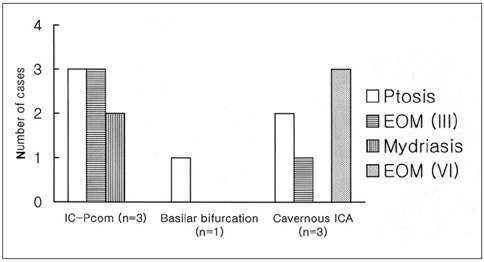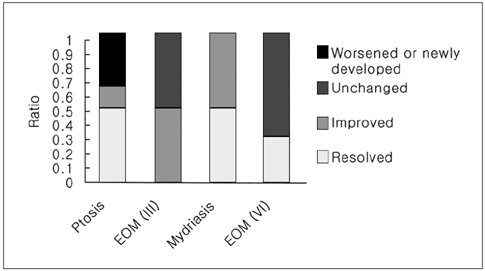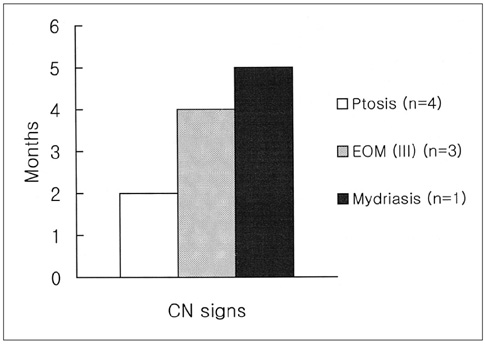Korean J Radiol.
2003 Sep;4(3):141-145. 10.3348/kjr.2003.4.3.141.
Unruptured Aneurysms with Cranial Nerve Symptoms: Efficacy of Endosaccular Guglielmi Detachable Coil Treatment
- Affiliations
-
- 1Department of Diagnostic Radiology, Yonsei University College of Medicine. dikim@yumc.yonsei.ac.kr
- KMID: 754016
- DOI: http://doi.org/10.3348/kjr.2003.4.3.141
Abstract
OBJECTIVE
To evaluate the efficacy of endosaccular Guglielmi detachable coil (GDC) treatment of unruptured aneurysms causing cranial nerve (CN) symptoms. MATERIALS AND METHODS: Among a database of 218 patients whose aneurysms were treated using GDC, seven patients met the criteria for unruptured aneurysms presenting with symptoms and signs of CN palsy. Changes in CN symptoms before and after GDC treatment were reviewed. RESULTS: Aneurysms were located in the internal carotid-posterior communicating artery (n=3), the basilar bifurcation (n=1) and the cavernous internal carotid artery (n=3). CN symptoms included ptosis (n=6), mydriasis (n=2), and extraocular muscle (EOM) disorder (CN III: n=4; CN VI: n=3). Overall, improvement or resolution of CN symptoms after treatment was noted in five patients. CN symptoms in cases involving small (< or =10 mm) and intradural aneurysms tended to respond better to GDC treatment. Ptosis was the initial symptom to show improvement, while EOM dysfunction responded least favourably. CONCLUSION: GDC coil packing appears to be an appropriate treatment method for the relief of CN symptoms associated with intracranial aneurysms.
Figure
Reference
-
1. Shimizu S, Kurata A, Takano M, et al. Tissue response of a small saccular aneurysm after incomplete occlusion with a Guglielmi detachable coil. AJNR Am J Neuroradiol. 1999. 20:546–548.2. Inamasu J, Nakamura Y, Saito R, Kuroshima Y, Ohba S, Ichikizaki K. Early resolution of third nerve palsy following endovascular treatment of a posterior communicating artery aneurysm. J Neuroophthalmol. 2002. 22:12–14.3. Birchall D, Khangure MS, McAuliffe W. Resolution of third nerve paresis after endovascular management of aneurysms of the posterior communicating artery. AJNR Am J Neuroradiol. 1999. 20:411–413.4. Malisch TW, Guglielmi G, Vinuela F, et al. Unruptured aneurysms presenting with mass effect symptoms: response to endosaccular treatment with Guglielmi detachable coils. Part I. Symptoms of cranial nerve dysfunction. J Neurosurg. 1998. 89:956–961.5. Giombini S, Ferraresi S, Pluchino F. Reversal of oculomotor disorders after intracranial aneurysm surgery. Acta Neurochir. 1991. 112:19–24.6. Drake CG. Giant intracranial aneurysms: experience with surgical treatment in 174 patients. Clin Neurosurg. 1979. 26:12–95.7. Ferguson GG, Drake CG. Carotid-ophthalmic aneurysms: visual abnormalities in 32 patients and the results of treatment. Surg Neurol. 1981. 16:1–8.8. Heros RC, Nelson PB, Ojemann RG. Large and giant paraclinoid aneurysms: surgical techniques, complications, and results. Neurosurgery. 1983. 12:153–163.9. Halbach VV, Higashida RT, Dowd CF, et al. The efficacy of endosaccular aneurysm occlusion in alleviating neurological deficits produced by mass effect. J Neurosurg. 1994. 80:659–666.10. Linskey ME, Sekhar LN, Hirsch W Jr., Yonas H, Horton JA. Aneurysms of the intracavernous carotid artery: clinical presentation, radiographic features, and pathogenesis. Neurosurgery. 1990. 26:71–79.11. Silva MN, Saeki N, Hirai S, Yamaura A. Unusual cranial nerve palsy caused by cavernous sinus aneurysms. Clinical and anatomical considerations reviewed. Surg Neurol. 1999. 52:143–148. discussion: 148-149.12. Brazis PW. Localization of lesions of the oculomotor nerve: recent concepts. Mayo Clin Proc. 1991. 66:1029–1035.
- Full Text Links
- Actions
-
Cited
- CITED
-
- Close
- Share
- Similar articles
-
- Endovascular Treatment of Cerebral Aneurysms: Detachable Coils and General Principles
- Intentional Sparing of Daughter Sac from Coil Packing in the Embolization of Aneurysms Causing the Third Cranial Nerve Palsy : Initial Clinical and Radiological Results
- GDC(Guglielmi Detachable Coil) Embolization Used in Carotid-Cavernous Fistula Incompletely Occluded by Detachable Balloon
- Direct Electrothrombosis of a Pseudoaneurysm after Obliteration of a Carotid Cavernous Fistula:Treatment with Guglielmi Detachable Coils: Case Report
- Recent Trends in the Treatment of Cerebral Aneurysms: Comparison between Endovascular Coil Embolization and Surgical Clipping




